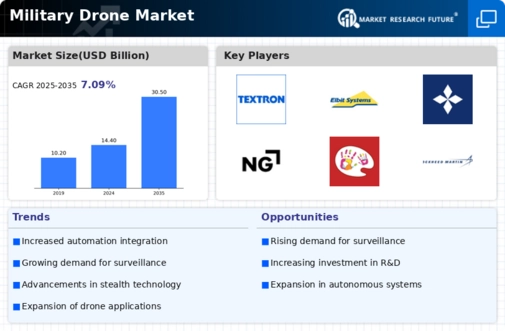Increased Defense Budgets
The Military Drone Market is experiencing a notable surge in defense budgets across various nations. Governments are increasingly recognizing the strategic advantages offered by unmanned aerial vehicles, leading to enhanced funding for research and development. For instance, defense budgets in several countries have seen annual growth rates of approximately 5 to 7 percent, with a significant portion allocated to drone technology. This trend indicates a commitment to modernizing military capabilities, thereby driving demand for advanced military drones. As nations seek to bolster their aerial surveillance and combat capabilities, the Military Drone Market is poised for substantial growth, reflecting the prioritization of unmanned systems in national defense strategies.
Technological Innovations
The Military Drone Market is witnessing rapid technological innovations that are reshaping the landscape of unmanned aerial systems. Advancements in artificial intelligence, machine learning, and sensor technologies are enhancing the capabilities of military drones. These innovations enable drones to perform complex missions with greater autonomy and precision. For instance, the integration of advanced imaging systems allows for real-time data collection and analysis, significantly improving situational awareness. As these technologies evolve, they are likely to drive the Military Drone Market forward, attracting investments and fostering competition among manufacturers to develop next-generation drones.
Rising Geopolitical Tensions
The Military Drone Market is significantly influenced by the escalating geopolitical tensions observed in various regions. Nations are increasingly investing in military drones as a means to enhance their surveillance and reconnaissance capabilities. The ongoing conflicts and territorial disputes have prompted countries to adopt advanced drone technologies to maintain strategic advantages. For example, the Middle East and Eastern Europe have seen heightened military activities, leading to increased procurement of drones. This trend suggests that the Military Drone Market will continue to expand as countries prioritize unmanned systems to address security challenges and assert their presence on the global stage.
Shift Towards Asymmetric Warfare
The Military Drone Market is being shaped by a shift towards asymmetric warfare strategies. As conventional military engagements evolve, there is a growing emphasis on utilizing drones to conduct operations that minimize risk to personnel while maximizing operational efficiency. This shift is particularly evident in counter-terrorism and counter-insurgency operations, where drones provide a tactical advantage. The ability to conduct precision strikes and gather intelligence without direct engagement has made military drones a preferred choice for many armed forces. Consequently, this trend is likely to drive the Military Drone Market as nations adapt their strategies to leverage the unique capabilities of unmanned systems.
Growing Demand for Surveillance and Reconnaissance
The Military Drone Market is experiencing a growing demand for surveillance and reconnaissance capabilities. Military organizations are increasingly utilizing drones for intelligence gathering, border security, and monitoring potential threats. The ability of drones to operate in diverse environments and provide real-time data has made them indispensable tools for modern warfare. Reports indicate that the demand for surveillance drones is expected to grow at a compound annual growth rate of around 10 percent over the next five years. This trend underscores the critical role of drones in enhancing operational effectiveness, thereby propelling the Military Drone Market to new heights.


















Leave a Comment